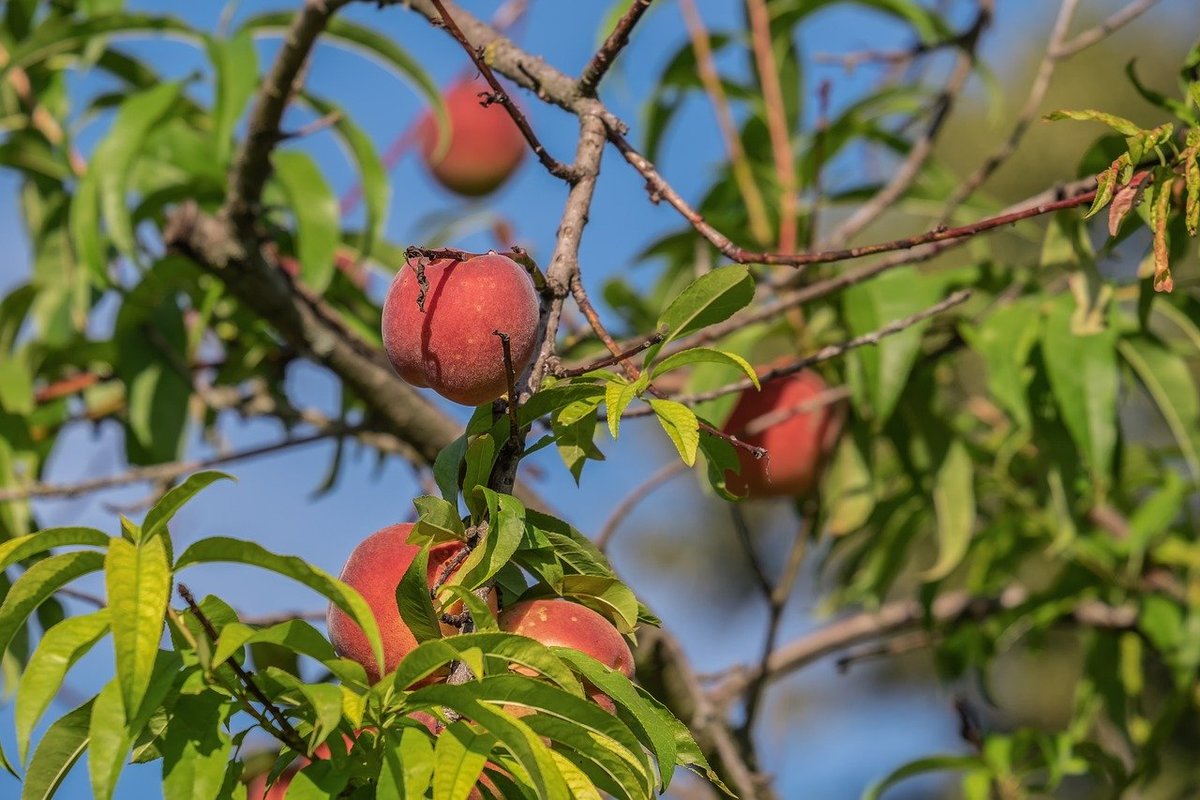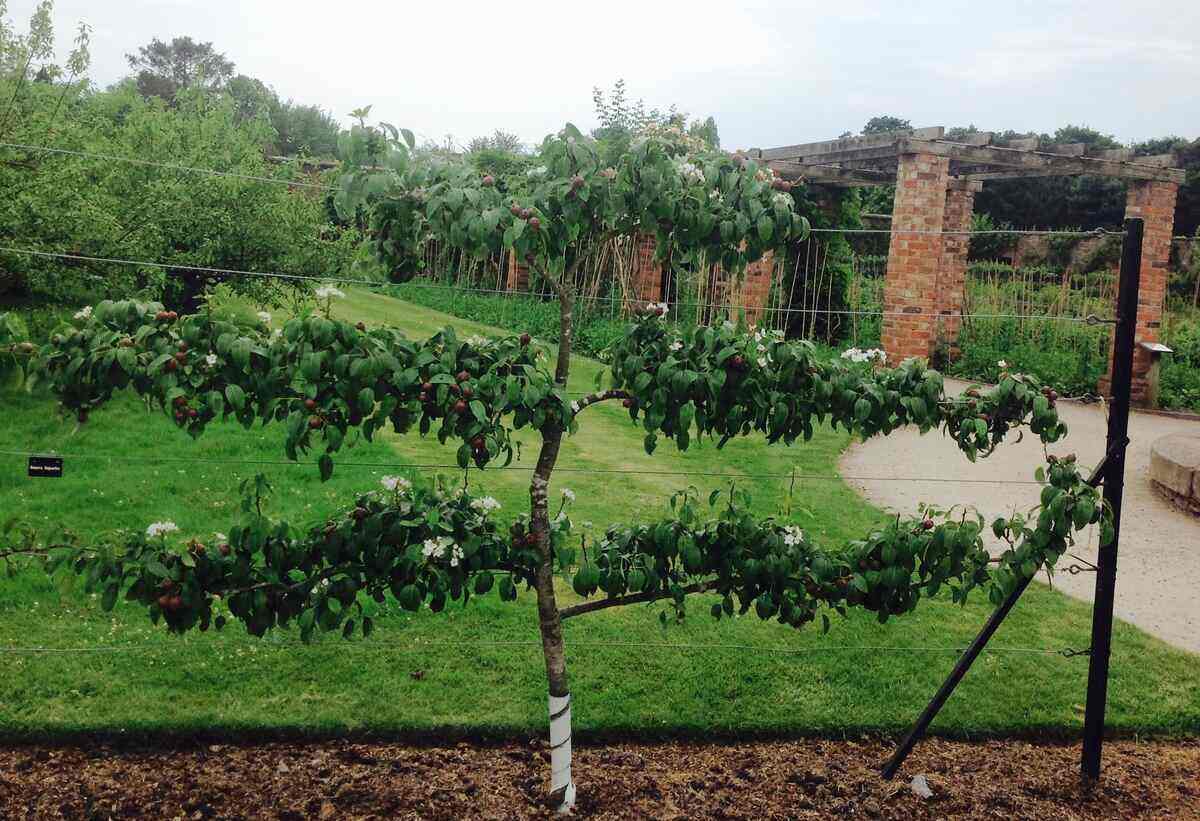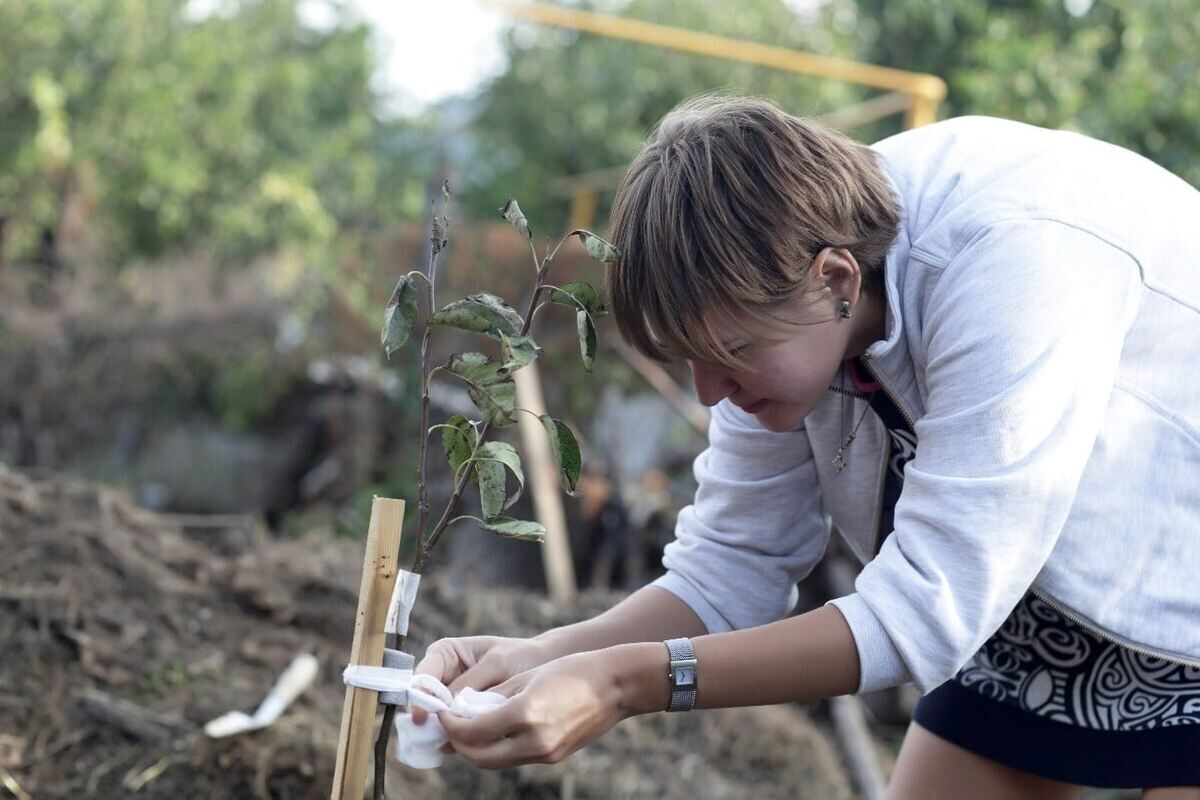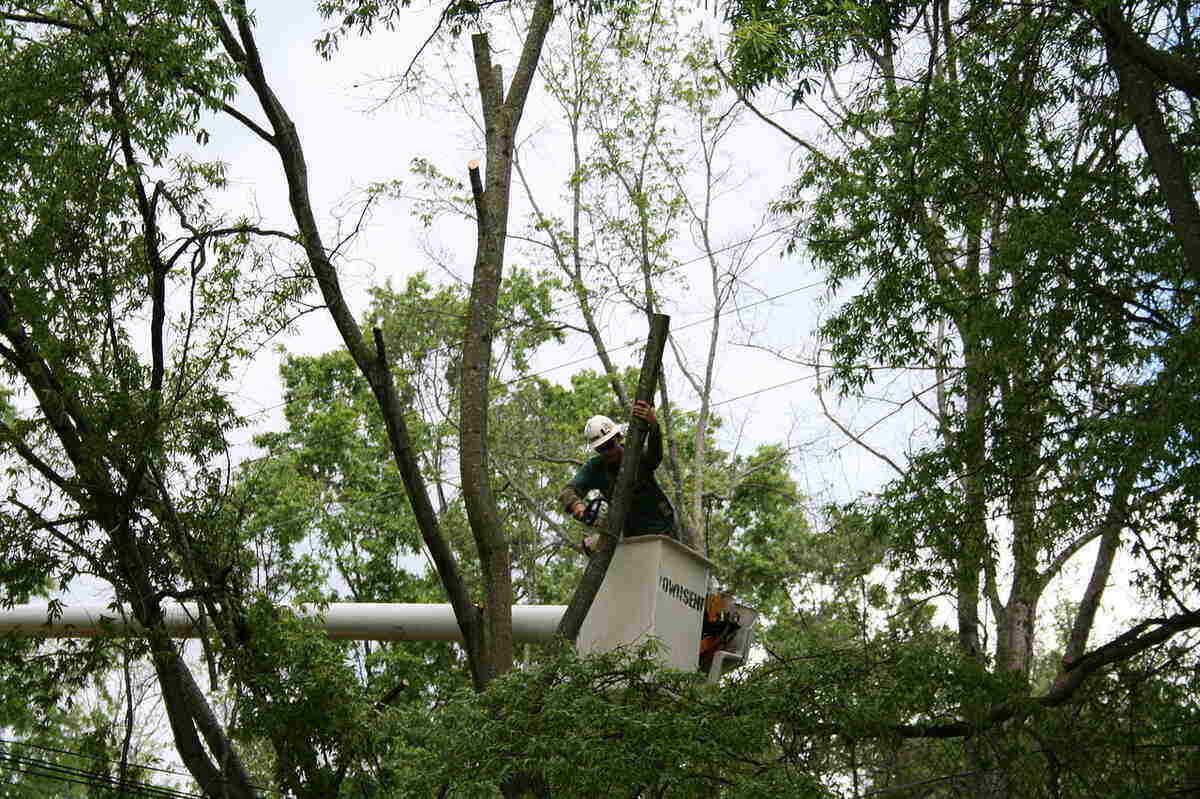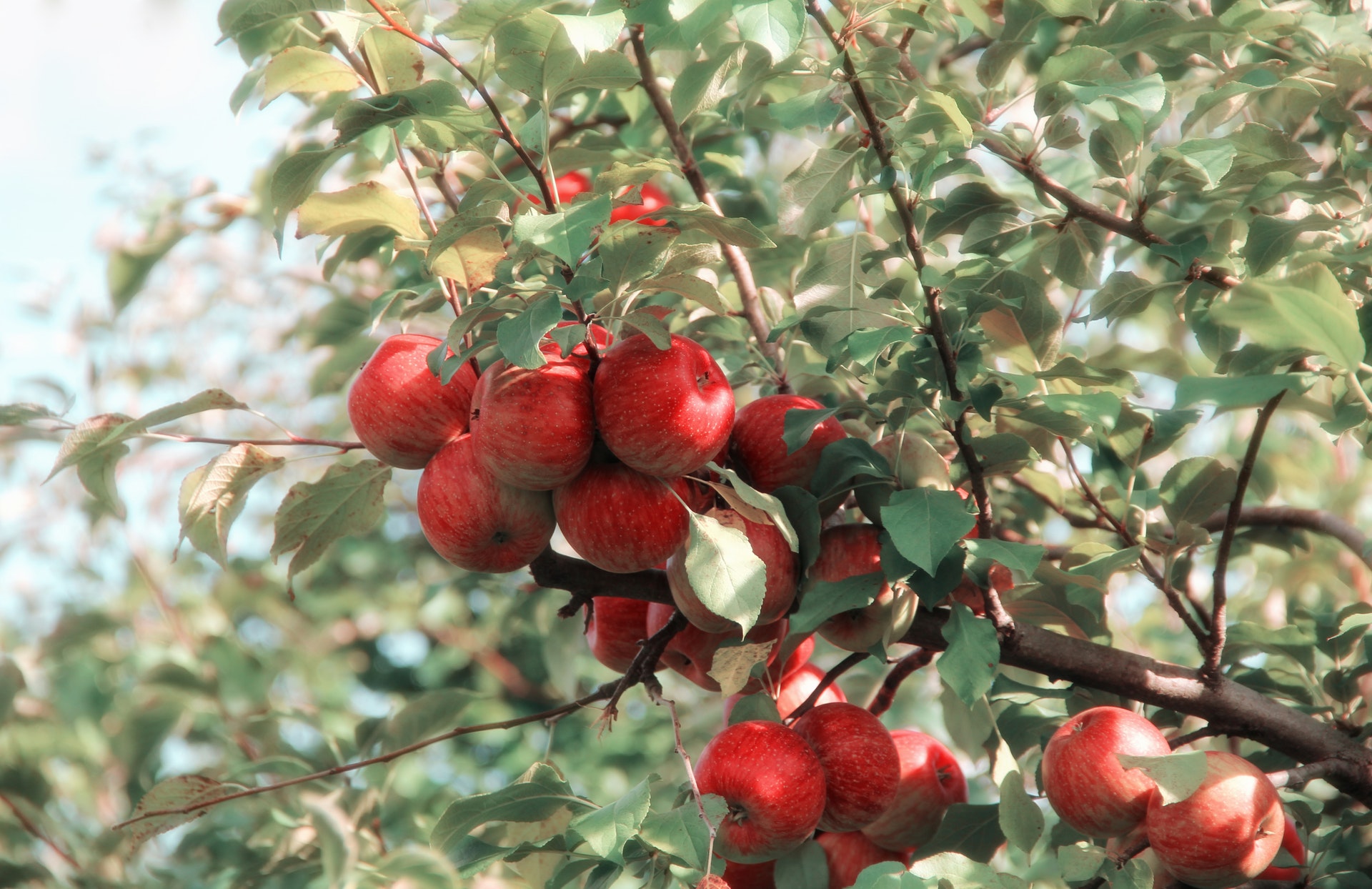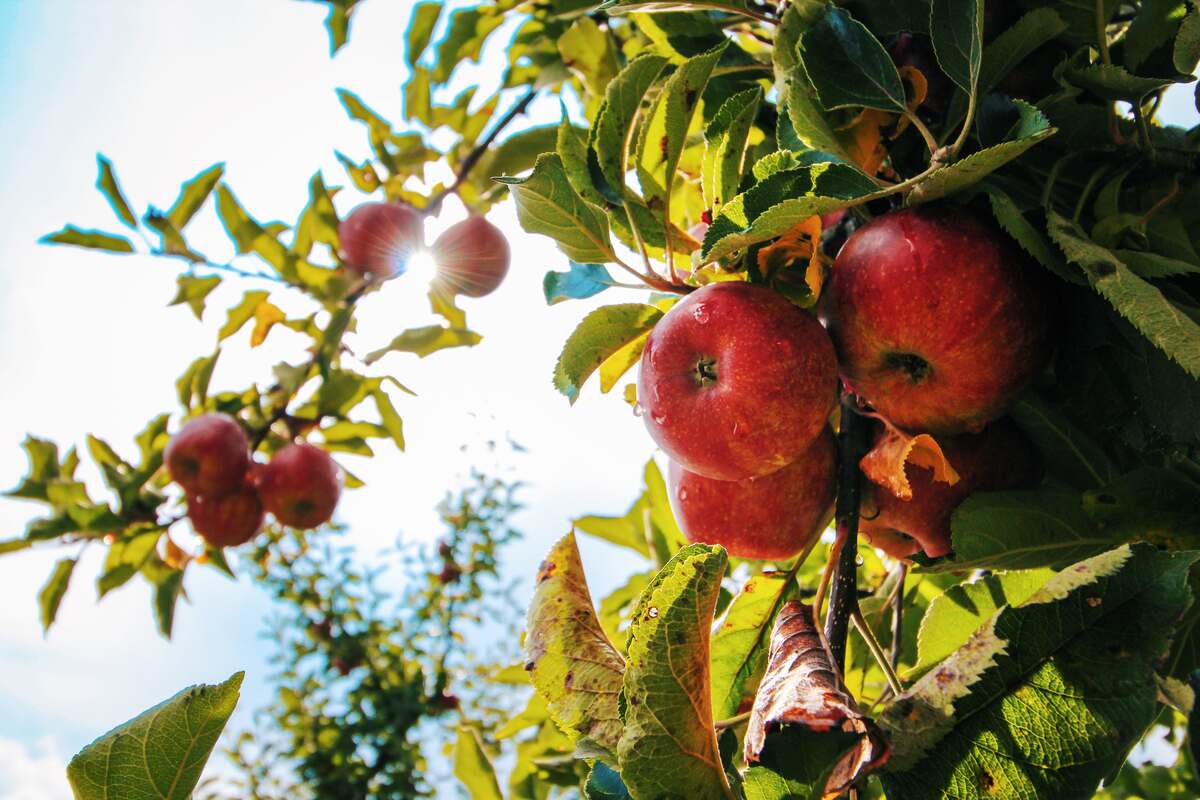
Pumpkin spice? Pffffftttt. I can take it or leave it. For me, fall means fresh-picked apples turned into mile-high pies with a crumb topping, warm apple crisp right out of the oven, and freshly pressed cider. But apple trees require basic pruning for the best yield. It isn’t as easy as pie, but we’ll show you when, why, and how to prune your apple trees to help you along the way.
Is Pruning Apple Trees Similar to Pruning Other Fruit Trees?
There are mixed opinions on whether pruning an apple tree is similar to pruning other fruit trees. Peach and nectarine trees produce fruit only on growth from the previous season, so they need a lot of pruning. Apple trees and pears produce fruit on long-lived branches called fruiting spurs, so they need less work. Other fruit trees fall between these two extremes.
So we’ll focus solely on apple trees today, but you can use the same general idea on pear trees if you have them in your yard. The tips in this apple tree pruning guide will help you to know when and how to prune apple trees for the most abundant crop of apples.
How Your Apple Tree Grows and Produces Fruit
To start with, understanding how an apple tree grows and produces fruit will help you understand the apple pruning process. Apple trees put on new growth every year, meaning new shoots will develop and grow. Existing branches add new growth, too. To find the new growth, look for a ring or band of tissue that completely encircles the shoot.
It’s important to be able to spot where the new growth is when it comes to pruning. Your tree will also create new flower buds in the season prior to blooming. In summer, it creates flower buds that will open up the following spring.
The flower buds develop at the tips of short shoots and on spurs (short thick growths on branches) in apple trees. Flower buds are more round in shape and swollen at the base compared to buds (vegetative or leaf buds) that develop into leaves.
- Buds that develop along the length of a shoot rarely develop into flowers.
- They may grow into spurs that develop flower buds the following year if they aren’t pruned incorrectly and triggered to develop new shoots.

How to Prune an Apple Tree
I think it’s safe to say that very few people like thinning their vegetable gardens or pruning their fruit trees. It seems counterintuitive to remove a plant or part of a plant that is growing well, but when done correctly, a properly pruned apple tree produces better fruit.
So let’s talk a bit more in-depth about how to prune, why you need to prune, and tips for a perfectly pruned apple tree. The how-to part of pruning includes:
- Pruning tools you’ll need for pruning an apple tree
- How to clean your tools and keep them clean
- Apple tree pruning in eight steps
- And three basic tree shapes so you can get started
Pruning Tools You’ll Need
A mature apple tree will have various sizes of branches, so you will need a couple of different tools to get the job done efficiently:
- Pruners: Also known as hand pruners or pruning shears, they are small enough to fit comfortably in your hand. Pruners work well for easy-to-reach, small branches and come in two different pruning tools: bypass and anvil. Bypass pruners are better for cutting live branches; anvil pruners are best for dead branches.
- Loppers: A good pair of loppers will cut through small to medium-sized branches. Long handles allow you to reach higher branches, plus they provide more cutting leverage for thicker cuts. Like pruners, they are available as bypass or anvil loppers.
- Saw: This is a must-have for larger branches. It is recommended to use a saw for anything larger in diameter than your thumb, but I’ll admit I use my loppers for branches up to about 1 inch in diameter.
It’s important to keep your tools sharp and clean when you are pruning fruit trees or any tree for that matter. Sharp tools result in cuts that quickly go through branches or stems without leaving a jagged, rough edge where the cut is made.
How to Clean Your Tools and Keep Them Clean
Before you start pruning, dip the cutting surfaces of pruners and loppers in isopropyl alcohol and allow them to air dry, disinfecting the metal. Dampen a clean cloth with isopropyl alcohol and carefully wipe your saw blade. This prevents the transfer and cross-contamination of any fungal or disease problems that may have been picked up from other plants/trees in your yard.
When you’re done for the day, carefully wipe off the sawdust and tree sap with a rag. Squirt a small amount of solvent on moving parts to keep them lubricated and free of rust.
Apple Tree Pruning in Eight Steps
How do you prune an apple tree correctly? Well, pruning isn’t a quick process. It can take a lot of work, depending on the scope of the project and the current state of your apple tree. The basic logic behind it is simple, though: Remove all dead branches, create the overall shape you desire, make detailed cuts to open up the interior canopy, and then finish with a basic trim.
- Assess your tree’s size and shape, paying careful attention to crowded or dead branches and limbs that are taller or longer than you want. This helps you decide what needs to be pruned and what cuts need to be made.
- Remove dead, damaged, or diseased branches first. Remove with a thinning cut if the entire branch is dead. If the tip is dead, remove the dead wood with a heading cut just above a side branch.
- Remove any new growth coming from the base of the trunk; these “suckers” originate from the rootstock instead of the fruiting variety that has been grafted on the upper part of the tree.
- Fix the overall size and shape. Remove branches too tall/long with thinning cuts or shorten them with heading cuts. This means the terminal branch(es) at the top of the tree, as well as the scaffolding branches that come out from the central leader.
- Open up the canopy through the center of the tree. The main branches need sufficient room for their lateral branches, and sunlight needs to access the interior and lower branches of the tree.
- Remove branches too close to one another or those growing back into the center of the tree with a thinning cut. Remove any branches growing toward the center of the tree with a thinning cut.
- Give the tree a haircut. Known as heading back, this encourages branches to grow shorter and thicker, as well as triggering lower growth in the canopy. It keeps your apple tree branches from continuing to grow upward and outward. Remember to be moderate and cut above a point where buds are growing away (outward) from the tree. (See video below.)
- Remove 20-30 percent of the active growth from last year using thinning cuts. It’s important to locate where the new growth starts. Prune the branches back to about one-quarter inch above an outward-facing bud to prevent new branches from growing into the center of the tree.
Here’s how to prune apple trees according to the experts.
Three Basic Tree Shapes
There are three basic ways to shape your apple tree:
1. Natural
A natural apple tree shape simply means you let your tree grow with little pruning. A large tree makes it hard to reach the top and produces smaller apples. While some people prefer this aesthetic, healthwise, it’s not best for your tree.
2. Cultivated into a specific shape
- Single leader trees: This pruning style has one trunk that dominates and grows upward, has several side limbs oriented horizontally off the main leader, and numerous fruiting branches that originate from the scaffold branches. Good for trees that are naturally short.
- Multiple leaders: Two or more dominant branches grow upward and angle out away from the tree center. This pruning style helps to maintain a shorter tree when you are growing a full-sized variety.
3. Espaliered to fit a small space
When a tree is pruned into an espalier shape, it is pruned to grow along a wall or trellis. This creates a vine-like “flat” tree. This isn’t a natural growth pattern for fruit trees, but it works well for those with limited yard space and is beautiful.
When to Prune
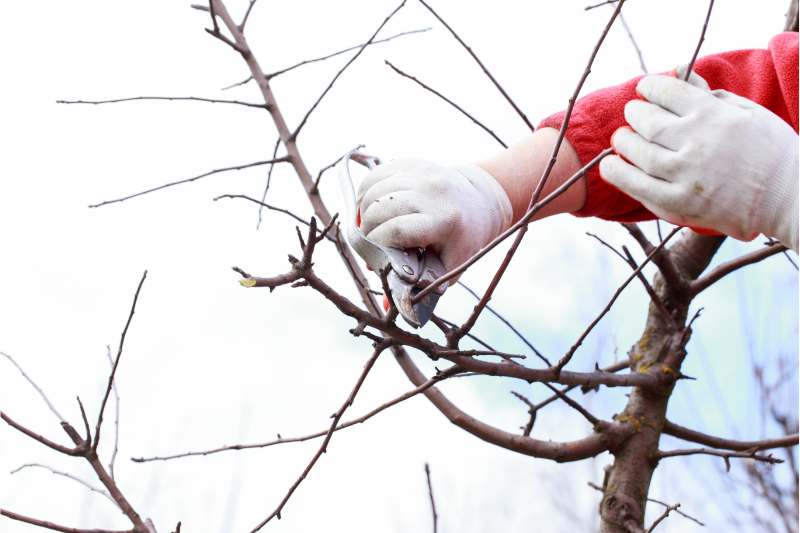
Another very important point is to know when to prune apple trees. Late winter or early spring – while the tree is still dormant and before active growth begins – is the best time of year to prune apple trees. Here are a few reasons why pruning apple trees in spring or late winter is ideal:
- Buds are easier to see and work around.
- Wounds from cuts have a chance to dry before insects come out in the spring.
Pro tip: Pruning lessens winter hardiness to a small extent, making the tree susceptible to winter injury from severely low temperatures for two to three weeks after planting. Watch your local long-range weather forecast and avoid pruning your apple tree when you see that temperatures will plummet within the two- to three-week range.
Summer Pruning
Summer is not the best season to trim apple trees. Summer pruning can be done in late July or August, but take care to avoid heavy pruning as it weakens the tree. Here are a few reasons to prune gently at this time:
- A weak tree slightly before harvest leads to a decrease in fruit size and quality.
- When loaded with fruit, there’s an increased possibility of snapped branches.
An important note: The local climate can affect the optimal time for pruning trees. For other types of trees in subtropical climates, trimming can be done practically all year round. But even so, winter pruning is the best practice for apple trees. January and early February are still the best time to prune apple trees in California and other areas with similar climates.
Why You Need to Prune
Your grass needs to be mowed and your hair needs to be cut periodically for good health (and to look nice). Your apple tree benefits from regular pruning, too. Here’s why:
- Too much shading is bad. A lack of sunlight through the interior and lower branches decreases flowering and weakens branches.
- Pruning improves air circulation which lessens apple pest and disease problems.
- Dead and dying branches harbor varmints and pests. They must be removed from the tree and your property, or burned.
- It keeps the tree at a manageable height for easier access when it’s time to pick.
- It opens the canopy and encourages larger, healthier fruit.
Less fruit leads to bigger apples. Think about it this way: A single tree has a given amount of resources. It has only so much water, sunlight, and nutrients in the growing season. All of the fruits divide those resources, and fewer apples mean each gets more resources to grow larger.
Two Types of Cuts
There are two basic types of pruning cuts: thinning cuts and heading cuts. The difference lies in how much of a shoot or branch is removed and how it affects the overall number of branches on your tree. Thinning cuts reduce the overall amount of branches on your tree while heading cuts increase the number by encouraging new shoot growth.
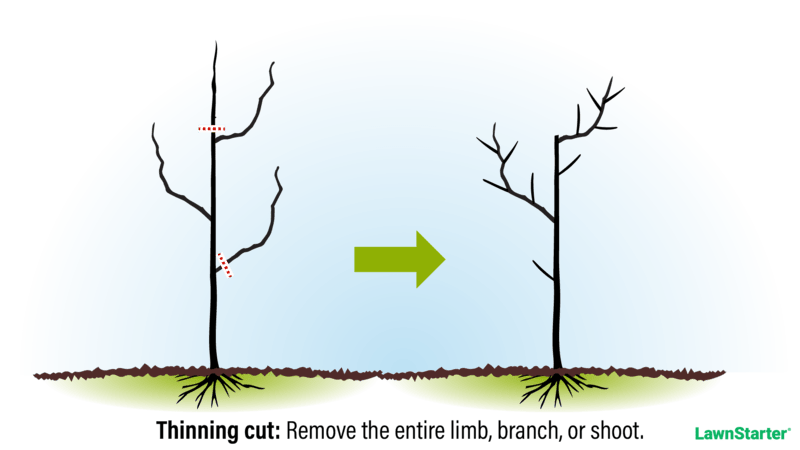
- Thinning: This cut consists of the complete removal of the shoot or branch at its base, which joins the rest of the limb. Thinning has little impact on the appearance of the tree. It’s great for removing dead branches or trimming excess limbs or branches. It also increases the development of flower buds.
- Heading: the removal of part of the shoot or branch. Heading cuts are useful for shortening branches. The heading cut changes the direction in which the shoot or branch is growing and alters the tree’s appearance.
Heading also invigorates the buds and shoots that are closest to the cut. A heading cut removes the terminal bud at the end of a shoot, then several shoots develop below the cut, creating a denser canopy.
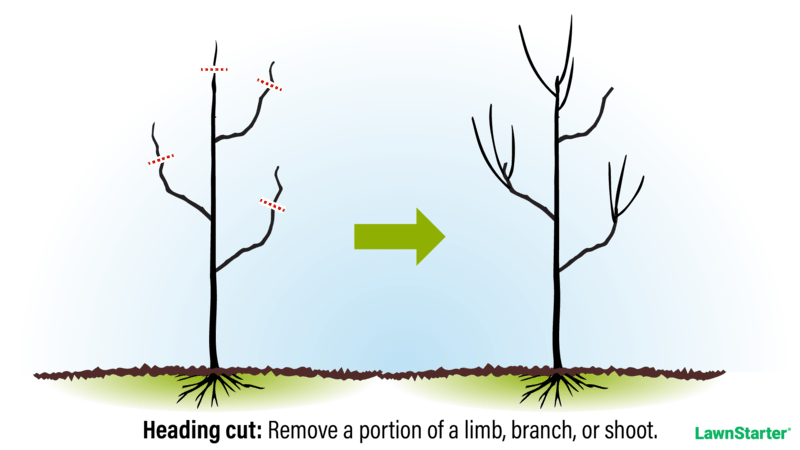
Tips for Effective Apple Tree Pruning
To finish up, keep the following tips in mind:
- Avoid over-pruning. If a tree has gone a couple of years without pruning, split the task. Do some pruning this year, followed by more next year to limit the stress you put on it. Prune less vigorous trees more severely to see them (hopefully) rebound quicker.
- Prune the branches with fewer buds/blossoms. If you have two live branches close together and you need to decide which one to remove, prune the branch with fewer buds/blossoms, or whichever is generally unproductive. Always keep the healthier, more productive branch of the two.
- Remove large branches in smaller sections to make it safer for you.
- Select branches to prune based on the angle at which they grow. Try to keep branches that grow upward at an angle. Remove branches that grow straight upward (water sprouts) or down toward the ground. “Water sprouts” are too vigorous and cast shade on lower branches. Branches that point down are weak and won’t bear fruit.
- Avoid pruning newly planted and young trees (after an initial pruning to determine the shape) until after the first couple of seasons your tree produces fruit. Pruning encourages leafy shoots instead of fruits, so it will delay fruit production in young apple trees.
- Clean up downed branches when you finish. That prevents any possible diseases or insect pests from reinfecting your tree.
FAQs
What Should I Do With Diseased and Pest-Riddled Branches and Limbs From my Apple Tree?
Always burn the discarded limbs, branches, and leaves once you have pruned your apple tree. If you can’t burn where you are, remove them from your property.
How Much Should I Prune From my Tree?
You should not prune more than 20-30 percent of any fruit tree per year. Also, avoid topping your apple trees since cutting off the top of your tree can damage it permanently.
Do Apple Trees Need to be Pruned Every Year?
Yes, you should prune apple trees every year. It helps them get through winter more easily, trims out dead or diseased branches, and spurs bud growth and vigor for springtime.
More Apples, More Happy
It seems counterintuitive to whack off parts of a tree to make it more productive and healthy. Just keep thinking of all the apple pies, applesauce, caramel apples, warm mulled cider, and all the apple goodies you love. Or, if you just can’t make the cut, why not hire a tree trimming professional to do it for you? I hear warm apple pies make a pretty good bartering item.
Main Image Credit: Tom Swinnen / Pexels
